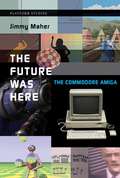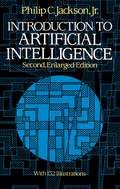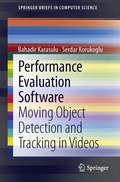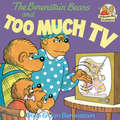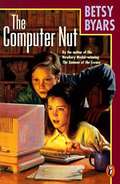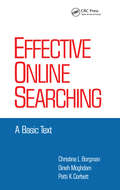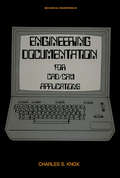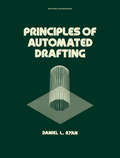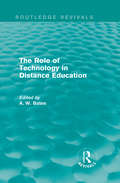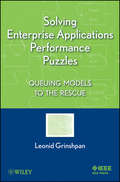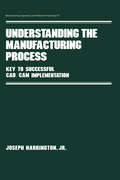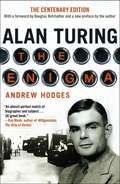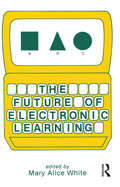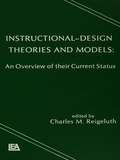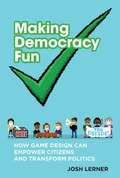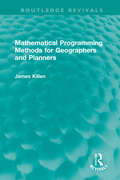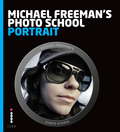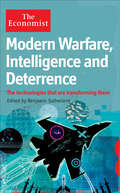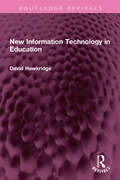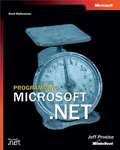- Table View
- List View
The Future Was Here: The Commodore Amiga
by Jimmy MaherLong ago, in 1985, personal computers came in two general categories: the friendly, childish game machine used for fun (exemplified by Atari and Commodore products); and the boring, beige adult box used for business (exemplified by products from IBM). The game machines became fascinating technical and artistic platforms that were of limited real-world utility. The IBM products were all utility, with little emphasis on aesthetics and no emphasis on fun. Into this bifurcated computing environment came the Commodore Amiga 1000. This personal computer featured a palette of 4,096 colors, unprecedented animation capabilities, four-channel stereo sound, the capacity to run multiple applications simultaneously, a graphical user interface, and powerful processing potential. It was, Jimmy Maher writes in The Future Was Here, the world's first true multimedia personal computer. Maher argues that the Amiga's capacity to store and display color photographs, manipulate video (giving amateurs access to professional tools), and use recordings of real-world sound were the seeds of the digital media future: digital cameras, Photoshop, MP3 players, and even YouTube, Flickr, and the blogosphere. He examines different facets of the platform--from Deluxe Paint to AmigaOS to Cinemaware--in each chapter, creating a portrait of the platform and the communities of practice that surrounded it. Of course, Maher acknowledges, the Amiga was not perfect: the DOS component of the operating systems was clunky and ill-matched, for example, and crashes often accompanied multitasking attempts. And Commodore went bankrupt in 1994. But for a few years, the Amiga's technical qualities were harnessed by engineers, programmers, artists, and others to push back boundaries and transform the culture of computing.
Introduction to Artificial Intelligence (Dover Books on Mathematics)
by Philip C. Jackson Jr.Can computers think? Can they use reason to develop their own concepts, solve complex problems, play games, understand our languages? This comprehensive survey of artificial intelligence ― the study of how computers can be made to act intelligently ― explores these and other fascinating questions. Introduction to Artificial Intelligence presents an introduction to the science of reasoning processes in computers, and the research approaches and results of the past two decades. You'll find lucid, easy-to-read coverage of problem-solving methods, representation and models, game playing, automated understanding of natural languages, heuristic search theory, robot systems, heuristic scene analysis and specific artificial-intelligence accomplishments. Related subjects are also included: predicate-calculus theorem proving, machine architecture, psychological simulation, automatic programming, novel software techniques, industrial automation and much more.A supplementary section updates the original book with major research from the decade 1974-1984. Abundant illustrations, diagrams and photographs enhance the text, and challenging practice exercises at the end of each chapter test the student's grasp of each subject.The combination of introductory and advanced material makes Introduction to Artificial Intelligence ideal for both the layman and the student of mathematics and computer science. For anyone interested in the nature of thought, it will inspire visions of what computer technology might produce tomorrow.
Performance Evaluation Software
by Serdar Korukoglu Bahadir KarasuluPerformance Evaluation Software: Moving Object Detection and Tracking in Videos introduces a software approach for the real-time evaluation and performance comparison of the methods specializing in moving object detection and/or tracking (D&T) in video processing. Digital video content analysis is an important item for multimedia content-based indexing (MCBI), content-based video retrieval (CBVR) and visual surveillance systems. There are some frequently-used generic algorithms for video object D&T in the literature, such as Background Subtraction (BS), Continuously Adaptive Mean-shift (CMS), Optical Flow (OF), etc. An important problem for performance evaluation is the absence of any stable and flexible software for comparison of different algorithms. In this frame, we have designed and implemented the software for comparing and evaluating the well-known video object D&T algorithms on the same platform. This software is able to compare them with the same metrics in real-time and on the same platform. It also works as an automatic and/or semi-automatic test environment in real-time, which uses the image and video processing essentials, e.g. morphological operations and filters, and ground-truth (GT) XML data files, charting/plotting capabilities, etc. Along with the comprehensive literature survey of the abovementioned video object D&T algorithms, this book also covers the technical details of our performance benchmark software as well as a case study on people D&T for the functionality of the software.
Short Season
by Scott Eller[from the back cover] "Striking Out For Brad, it's always been great having an older brother like Dean--to play stickball with, to have as a buddy or just to talk to. And on the baseball field, Dean's golden glove and Brad's hitting eye can't be beat. They're more than brothers--they're a team. But Dean's been acting different lately, and Brad doesn't know why. He hardly talks to Brad anymore--all of a sudden he's just too busy. Things are bad enough, but the league play-offs are coming up, and Brad doesn't have Dean to cover for him in the outfield anymore. Brad's spent his life being part of a team--can he really make it on his own?"
Artificial Intelligence (2nd edition)
by Patrick H. WinstonThis is an eagerly awaited revision of the single bestselling introduction to Artificial Intelligence ever published. It retains the best features of the earlier works including superior readability, currency, and excellence in the selection of the examples.
The Berenstain Bears and Too Much TV (First Time Books(R))
by Stan Berenstain Jan BerenstainCome for a visit in Bear Country with this classic First Time Book® from Stan and Jan Berenstain. Papa, Brother, and Sister have a new favorite hobby . . . watching TV. But when Mama feels like they are missing out on all the wonderful things around them, she makes a plan to get them away from the TV and into the outdoors. This beloved story is a perfect way to teach children that there can be too much of a good thing.
The Computer Nut
by Betsy ByarsTen-year-old Kate begins a communication exchange on a computer with someone purporting to be from outer space, who says he is going to pay a visit to Earth soon.
Effective Online Searching: A Basic Text
by Christine L. Borgman Dineh Moghdam Patti K. CorbettThis book focuses on searching and hands-on experience, which makes the text suitable for those who wish to learn searching for their own use as well. It is intended for those who will act as search intermediaries, accepting questions from clients and performing the searches.
Engineering Documentation for CAD/CAM Applications (Dekker Mechanical Engineering Ser. #30)
by Charles S. KnoxThis book emphasizes the importance of consistent, well-planned, and computer-oriented engineering documentation systems to engineering, manufacturing, and accounting. It discusses the systems needed to optimize flow of information and increase the efficiency of modern CAD/CAM systems.
Principles of Automated Drafting (Mechanical Engineering Ser. #28)
by Daniel L. RyanThis book introduces the reader to each phase of the subject, step-by-step to enable one to use the various automated drafting devices, instruments and technique of application. It shows the way to produce acceptable drafting in the framework of high productivity.
The Role of Technology in Distance Education (Routledge Revivals)
by Tony BatesThis book, first published in 1984, provides a comprehensive review of the range of technology that was being used in distance education. Technological developments in word processing, video-disc and viewdata as well as computer-based learning had revolutionised the potential for distance education. These developments required the role of more ’conventional’ distance learning media, such as broadcasting, tuition and text, to be reassessed. This book, written by international experts in the field, explored the state of the art at the time, and also provided their ideas on how future developments were likely to evolve. This book is ideal for those studying education and communications.
Solving Enterprise Applications Performance Puzzles
by Leonid GrinshpanPoorly performing enterprise applications are the weakest links in a corporation's management chain, causing delays and disruptions of critical business functions. This groundbreaking book frames enterprise application performance engineering not as an art but as applied science built on model-based methodological foundation. The book introduces queuing models of enterprise application that visualize, demystify, explain, and solve system performance issues. Analysis of these models will help to discover and clarify unapparent connections and correlations among workloads, hardware architecture, and software parameters.
Understanding the Manufacturing Process: Key to Successful Cad/cam Implementation
by Joseph Harrington Jr.This book approaches manufacturing as a basic problem of making a desired end-product from bulk raw materials. It encompasses the entire gamut of activities from product concept to maintenance of past products in the field, and everything in between.
Windows® 7 Plain & Simple
by Marianne Moon Jerry JoyceGet the fast facts that make learning Windows 7 plain and simple! This no-nonsense guide uses easy, numbered steps and concise, straightforward language to show the most expedient way to perform tasks and solve problems in Windows 7. Here's what you'll learn to do: Run programs, control gadgets, play games. Send e-mail, browse the Web, and share your files. Organize your digital media, including photos, music, and videos. Burn CDs and DVDs; make your own movies. Set up your printer and a simple home network. Manage security settings and perform easy tune-ups and fixes. Here's how you'll learn it: Jump in wherever you need answers. Easy-to-follow steps and screenshots show you exactly what to do. Handy tips teach you new techniques and shortcuts. Quick TRY THIS! exercises help you apply what you've learned right away. offer the CD/DVD content as a free download via OReilly Medias Digital Distribution services. To download this content, please visit OReillys web site, search for the title of this book to find its catalog page, and click on the link below the cover image (Examples, Companion Content, or Practice Files). Note that while we provide as much of the media content as we are able via free download, we are sometimes limited by licensing restrictions. Please direct any questions or concerns to booktech@oreilly.com.
Adaptive Technologies for Training and Education
by Paula J. Durlach Alan M. LesgoldThis edited volume provides an overview of the latest advancements in adaptive training technology. Intelligent tutoring has been deployed for well-defined and relatively static educational domains such as algebra and geometry. However, this adaptive approach to computer-based training has yet to come into wider usage for domains that are less well defined or where student-system interactions are less structured, such as during scenario-based simulation and immersive serious games. In order to address how to expand the reach of adaptive training technology to these domains, leading experts in the field present their work in areas such as student modeling, pedagogical strategy, knowledge assessment, natural language processing and virtual human agents. Several approaches to designing adaptive technology are discussed for both traditional educational settings and professional training domains. This book will appeal to anyone concerned with educational and training technology at a professional level, including researchers, training systems developers and designers.
Alan Turing: The Enigma (The Centenary Edition)
by Andrew HodgesIt is only a slight exaggeration to say that the British mathematician Alan Turing (1912-1954) saved the Allies from the Nazis, invented the computer and artificial intelligence, and anticipated gay liberation by decades--all before his suicide at age forty-one. This classic biography of the founder of computer science, reissued on the centenary of his birth with a substantial new preface by the author, is the definitive account of an extraordinary mind and life. A gripping story of mathematics, computers, cryptography, and homosexual persecution, Andrew Hodges's acclaimed book captures both the inner and outer drama of Turing's life. Hodges tells how Turing's revolutionary idea of 1936--the concept of a universal machine--laid the foundation for the modern computer and how Turing brought the idea to practical realization in 1945 with his electronic design. The book also tells how this work was directly related to Turing's leading role in breaking the German Enigma ciphers during World War II, a scientific triumph that was critical to Allied victory in the Atlantic. At the same time, this is the tragic story of a man who, despite his wartime service, was eventually arrested, stripped of his security clearance, and forced to undergo a humiliating treatment program--all for trying to live honestly in a society that defined homosexuality as a crime.
The Future of Electronic Learning
by Mary Alice WhiteFirst Published in 1983. Routledge is an imprint of Taylor & Francis, an informa company.
Instructional Design Theories and Models: An Overview of Their Current Status
by Charles M. ReigeluthInstructional Design Theories and Models is a thorough yet concise overview of eight of the most comprehensive and best-known attempts to integrate knowledge about effective and appealing instruction. Chapters were written by the original theorists to provide a more accurate and behind-the-scenes look at the theories' development. Instructional Des
Making Democracy Fun
by Josh LernerAnyone who has ever been to a public hearing or community meeting would agree that participatory democracy can be boring. Hours of repetitive presentations, alternatingly alarmist or complacent, for or against, accompanied by constant heckling, often with no clear outcome or decision. Is this the best democracy can offer? In Making Democracy Fun, Josh Lerner offers a novel solution for the sad state of our deliberative democracy: the power of good game design. What if public meetings featured competition and collaboration (such as team challenges), clear rules (presented and modeled in multiple ways), measurable progress (such as scores and levels), and engaging sounds and visuals? These game mechanics would make meetings more effective and more enjoyable -- even fun. Lerner reports that institutions as diverse as the United Nations, the U.S. Army, and grassroots community groups are already using games and game-like processes to encourage participation. Drawing on more than a decade of practical experience and extensive research, he explains how games have been integrated into a variety of public programs in North and South America. He offers rich stories of game techniques in action, in children's councils, social service programs, and participatory budgeting and planning. With these real-world examples in mind, Lerner describes five kinds of games and twenty-six game mechanics that are especially relevant for democracy. He finds that when governments and organizations use games and design their programs to be more like games, public participation becomes more attractive, effective, and transparent. Game design can make democracy fun -- and make it work.
Mathematical Programming Methods for Geographers and Planners (Routledge Revivals)
by James KillenOriginally published in 1983, this was the first text to offer an in-depth treatment of mathematical programming methods explained from first principles. It considers all the major programming techniques and fully explains key terms, illustrates theories with detailed examples and shows how the various skills are applied in practice. It will be invaluable in both the academic world and to policy formulators and planners, who make extensive use of the methods described.
Michael Freeman's Photo School: Portrait (Michael Freeman's Photo School)
by Michael FreemanAt some point, all photographers are called upon to shoot a proper portrait - combining technical skill with personable demeanour to capture someone in their best possible light. Michael Freeman teaches you how to achieve flattering portrait results with a variety of both traditional and modern styles.Learn how to set your subjects at ease and bring out their natural beauty with a friendly yet professional attitude. Feel confident giving directions on posing and stance with a thorough review of the classic approaches, from head-and-shoulder shots to full-length compositions, and everything in between.Take creative control of your portrait sessions by learning to manipulate the light to your own ends - whether that means bouncing sunlight o a reflector or building your own studio setups with multiple fl ash units. The complex science of photographic lighting is explained in straightforward and easy-to-understand language, with abundant and inspirational examples. Finally, master the fundamentals of post-production finishing techniques to make sure every portrait looks its absolute best. Your subjects will thank you for it!
Mind at Play: The Psychology of Video Games
by Geoffrey. R. Loftus Elizabeth F. LoftusExamines the psychological processes involved in playing video games, discusses behavior problems frequent players can develop, and compares video games to other fads of the past.
Modern Warfare, Intelligence and Deterrence: The technologies that are transforming them (Economist Books)
by Benjamin SutherlandThe Panzerfaust-3, a German shoulder-fired heat-seeking antitank missile, can punch through a metre of solid steel-far more than any armoured vehicle could carry. The MPR-500, an Israeli precision bomb, can hammer through several storeys of a building and explode on a chosen floor. These and myriad other military and intelligences technologies are changing the world. This Economist book describes these emerging technologies and places them in the larger context of today's politics, diplomacy, business and social issues. It shows how efforts to win wars or keep the peace are driving enormous and multifold technological advances. Broadly speaking, defence technologies will continue to provide enormous advantages to advanced, Western armed forces. The book is organised into five parts: land and sea, air and space, the computer factor, intelligence and spycraft, and the road ahead, which examines the coming challenges for western armies, such as new wars against insurgents operating out of civilian areas. Comprising a selection of the best writing on the subject from the Economist, each part has an introduction linking the technological developments to political, diplomatic, business and other civilian matters. For anyone who wants to know just how smart the global war, defence and intelligence machine is, this will be revealing and fascinating reading.
New Information Technology in Education (Routledge Revivals #32)
by David HawkridgeFirst published in 1983, New Information Technology in Education surveyed developments in the field of information technology and demonstrated how it could be used to improve the quality of education. The book considered the experience of a wide range of countries, including the United States, Japan and those in Europe. While explaining the potential improvements that the new technology could bring, this book also reviewed the problem areas and helped educationalists to evaluate the relevance of the new technology for their own work. In an age of teaching via Zoom videos, it is interesting to take a look at a time when information technology in education was at its nascent stage. This book will be of interest to teachers and students of history, education, technology and pedagogy.
Programming Microsoft® .NET
by Jeff ProsiseThe Microsoft .NET initiative builds on industry standards to make interoperable software services available anywhere, on any device, over the Internet. Behind the initiative is the Microsoft .NET Framework, which combines a managed run-time environment with one of the richest class libraries ever invented to make building and deploying Web-enabled applications easier than ever. Find out how to leverage the full power of the .NET Framework with this definitive, one-stop resource, wri tten by a leading authority in his trademark easy-to-follow, conversational style. You'll learn about the key programming models embodied in the .NET Framework, including Windows® Forms, Web Forms, and XML Web services. And you'll benefit from a wealth of how-to examples, code samples, and complete working programs in C#. Topics covered in this guide include: Hello, .NET Types and Exceptions The .NET Framework Class Library Windows Forms Web Forms Web Controls User Controls Custom Controls Web Applications Microsoft ASP.NET Security XML Web Services Microsoft ADO.NET XML Multithreading Remoting CD-ROM FEATURES: A fully searchable electronic version of the book Source code for more than 60 complete sample programs and components written in C# The Microsoft .NET Framework SDK, plus Service Pack 1 A Note Regarding the CD or DVD The print version of this book ships with a CD or DVD. For those customers purchasing one of the digital formats in which this book is available, we are pleased to offer the CD/DVD content as a free download via O'Reilly Media's Digital Distribution services. To download this content, please visit O'Reilly's web site, search for the title of this book to find its catalog page, and click on the link below the cover image (Examples, Companion Content, or Practice Files). Note that while we provide as much of the media content as we are able via free download, we are sometimes limited by licensing restrictions. Please direct any questions or concerns to booktech@oreilly.com.
